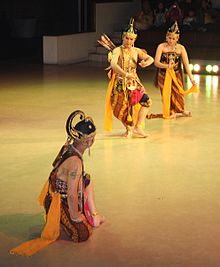
Back Wayang wong BAN Wayang wong ID Ringgit tiyang JV Wayang Wong Dutch Ваянг вонг Russian Wayang wong Priangan Sundanese 哇揚翁戲 Chinese
| Wayang wong | |
|---|---|
 | |
| Types | Traditional |
| Ancestor arts | Javanese |
| Descendant arts | Balinese |
| Originating culture | Indonesia |
| Three genres of traditional dance in Bali | |
|---|---|
| Country | Indonesia |
| Reference | 617 |
| Region | Asia and the Pacific |
| Inscription history | |
| Inscription | 2015 |
 Wali Sacred Dances (Rejang, Sanghyang Dedari, Baris Upacara), Bebali Semi sacred Dances (Topeng Sidhakarya/Topeng Pajegan, Gambuh dance drama, Wayang Wong dance drama), Balih-balihan Entertainment Dances (Legong Kraton, Joged Bumbung, Barong Ket) | |
| Wayang wong |
|---|
|
| Burma |
| Cambodia |
| Indonesia |
|
| Laos |
| Malaysia |
| Philippines |
| Thailand |
|
| Vietnam |
Wayang wong (Javanese: ꦮꦪꦁꦮꦺꦴꦁ), also known as wayang orang (literally "human wayang"), is a type of classical Javanese and Balinese dance theatrical performance with themes taken from episodes of the Ramayāna or Mahabharāta. Performances are stylised, reflecting Javanese court culture:
Wayang wong dance drama in the central Javanese Kraton (royal court) of Yogyakarta represents the epitome of Javanese aesthetic unity. It is total theatre involving dance, drama, music, visual arts, language, and literature. A highly cultured sense of formality permeates every aspect of its presentation.[1]
Despite being closely associated with Javanese and Balinese tradition, variants of wayang wong dance drama can also be found in neighboring Javanese ethnic traditions, including Sundanese tradition.
© MMXXIII Rich X Search. We shall prevail. All rights reserved. Rich X Search
